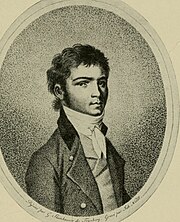music.wikisort.org - Composition
The String Quartet No. 2 in G major, Op. 18, No. 2 (actually his third), was written by Ludwig van Beethoven between 1798 and 1800 and published in 1801, dedicated to Joseph Franz von Lobkowitz.
| String Quartet | |
|---|---|
| No. 2 | |
| Early string quartet by Ludwig van Beethoven | |
 Ludwig van Beethoven, c. 1796 | |
| Key | G major |
| Opus | 18, No. 2 |
| Composed | 1798–1800 |
| Dedication | Joseph Franz von Lobkowitz |
| Published | 1801 |
| Movements | Four |
It consists of four movements:
- Allegro (G major)
- Adagio cantabile – Allegro – Tempo I (C major)
- Scherzo: Allegro (G major)
- Allegro molto, quasi presto (G major)
Of the Op. 18 string quartets, this one is the most grounded in 18th-century musical tradition.[1] According to Steinberg, "In German-speaking countries, the graceful curve of the first violin's opening phrase has earned the work the nickname of Komplimentier-Quartett, which might be translated as 'quartet of bows and curtseys'."[2]
The nickname may have originated from one of Haydn's last string quartets written about the same time (Op. 77, No. 1; 1799[3]), which was also known as the Komplimentier-Quartett. Haydn was Beethoven's teacher at the time, and there are similarities in style between the two quartets. They are also both in the key of G major.[4]
After he finished the quartet, Beethoven was not satisfied with the second movement and wrote a replacement. Sketches of the original slow movement survive and a complete version has been reconstructed by musicologist Barry Cooper.[5] It was performed publicly, possibly for the first time, by the Danel Quartet in the Cosmo Rodewald Concert Hall at the Martin Harris Centre, University of Manchester, on 30 September 2011.
References
- Winter + Martin, p. 155
- Winter + Martin, p. 156
- String Quartet No. 66 in G major, FHE No. 13, Hoboken No. III:81
- The string quartets of Joseph Haydn. Banat Blog (in German), 19 April 2009. Retrieved 10 September 2011.
- 'Lost' Beethoven work to be aired BBC News, 28 September 2011, retrieved 12 October 2011.
Bibliography
- Robert Winter, Robert Martin eds. (1994). The Beethoven Quartet Companion. University of California Press. ISBN 0-520-08211-7.; especially the essay by Michael Steinberg (pp. 155–159)
External links
- String Quartet No. 2: Scores at the International Music Score Library Project
Другой контент может иметь иную лицензию. Перед использованием материалов сайта WikiSort.org внимательно изучите правила лицензирования конкретных элементов наполнения сайта.
WikiSort.org - проект по пересортировке и дополнению контента Википедии